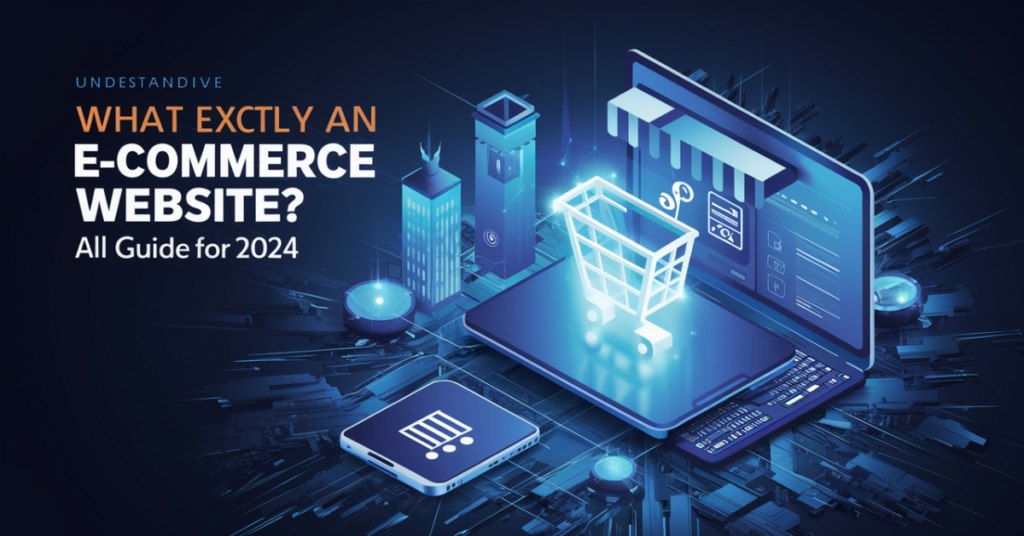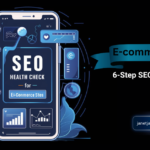Last Updated on June 23, 2025 by janetjacksondigital

A website that enables online sales and purchases of goods, services, digital products in lieu of physical shops is known as an electronic commerce website. An e-commerce website allows a business to manage orders, collect payments, arrange shipping and other logistics, and provide customer service.
It’s difficult to envision modern life without online shopping. In addition to ordering food, clothes, and furniture, we also download music, movies, and books. We also register for classes and use other internet services. E-commerce is here to stay and has become a major force.
“E-commerce” can be defined as the basic online selling of goods and services. The electronic transfer of funds and data between two or more parties is the most fundamental kind of e-commerce. Since its origins in the 1960s with electronic data interchange and the 1990s with the emergence of online purchasing, this form of company has undergone significant evolution.
What is an e-commerce site?
Similar to a traditional retail store, e-commerce sites let businesses and consumers purchase and sell goods to each other through a specified platform. The primary distinction between physical and online commerce Instead of taking place in a physical store, all e-commerce transactions are completed online.
What is WooCommerce? 2024’s Top eCommerce Platform
Physical items
Clothing food, furniture, or other supplies are physical items that can be kept in warehouses. Sellers advertise their goods on their online store and customers can choose to either buy, save or buy the items. After purchase, the company sends the item to the purchaser.
Services
Services sites are also a common method to offer services such as services for consultations or maintenance, tutoring lessons, and much more. You may want to learn how to code for a website, or are looking for an experienced trainer who can aid in fixing your dog’s nagging barking behavior There’s a wealth of support online.
Digital products
On e-commerce websites and other websites, digital courses—such as online courses, music, podcasts, software, and e-books—are growing in popularity. The popularity of digital goods provides a fresh opportunity to acquire abilities in a matter of minutes.
What actions should your online store take?
Your online store must to be capable of:
- Take commands.
- Accept Payments
- Organize logistics and shipping.
- Offer client support.
When you’re selling products and services on the internet, there are a few essential functions that every e-commerce website must have.
Accept orders
If you’re operating a business which sells a product your online store must be able accept orders from customers. You might not realize how complicated this can be. Each time you place an order your website will have to:
- Record customer information (name, address, etc.)
- Customers must signify their acceptance of your conditions of service
- Calculate any taxes applicable.
- Make use of coupons or discounts
- Generate tracking and order numbers for tracking and order.
- Share delivery details
- Process the billing details
- Access to a payment gateway
Pay your bills
The switch from your website to an online payment processor ought to go smoothly. In general, the payment processors permit customers to:
- Choose a payment method
- Give details, such as CVV numbers and credit card numbers.
- Utilize multi-step authentication to ensure secure transactions
Manage logistics and shipping
Once your site has processed the payment and order process for a client The next step is the delivery.
As an online seller, your aim is to make sure that your customers get their desired product on time and in pristine quality. To facilitate this process you may either manage logistics and shipping yourself or work with a third party service. Whichever method you decide to use your site should be able to start the process in a timely and consistent manner.
Your website will also have to have a procedure that allows for the return of products. This is also referred to as reverse logistics, and it is equally important as the outbound product shipment procedure.
Customer service is provided
Your customers are bound to require communication from you regarding their purchase or experience. They may have to change their personal information, arrange an exchange or return an item that is defective. Your website is the first place these customers will go to contact you. The simpler it is for customers to communicate with you – via the use of a contact form or chat services, for example — the simpler it will be for them to address their concerns swiftly.
What metrics should you be tracking?
Monitoring e-commerce measures can allow you to gauge performance, revealing what’s working well for your customers, and what may require improvement. Many e-commerce platforms offer built-in tracking of data, however for truly comprehensive metrics, you’ll need to connect your site to an analytics platform like Google Analytics.
Traffic to websites
Your web visitors is a clear measure of your site’s visitors and the amount of visitors who purchase something when they’re on your site. It is often an accurate picture of the success of your most recent E-commerce marketing strategies.
Rate of bounce
The percentage of individuals that visit only one page or one area of your website before leaving is known as your website’s bounce rate. If you notice an increase in bounce rates customers are probably not making a lot of purchases and it’s crucial to determine the reason they’ve left. The reason could be due to pricing, marketing or the design of your website or a myriad of other reasons.
Conversion rate of visitors
It is the visitor’s percentage of conversion shows the percentage of site visitors who convert into paying customers. Conversion rates are crucial as they demonstrate how well you can convince people to buy. If you’re experiencing a low conversion rate, your customers are signaling there’s something wrong with your company or marketing.
Cart abandonment rate
Like the physical shop in a physical store, it is the same with an online store. empty cart in the world of e-commerce is one that’s empty and abandoned by the buyer. Although abandoned carts can be difficult for sellers but they’re also not necessarily an indicator of bad quality. Many customers make use of their carts as an inventory or a placeholder while they search to find the perfect product.
No matter what, you want customers to be re-engaged and purchase items from their shopping cart. It is possible to encourage customers to finish the purchase with a coupon or sending them a promo email.
Email subscriber engagement
It’s simple to monitor the number of people who are viewing your emails, and the percentage of those who are becoming customers. Monitoring your subscribers’ engagement with your emails will help you identify the aspects of your marketing via email are working and what needs some improvement.
Mobile users
Mobile seo-based e-commerce has become so commonplace that it’s been given its own name– “m-commerce”. Because of this, monitoring the quantity of mobile visitors to your website is even more crucial. It is also important to keep track of the percentage of mobile visitors ultimately become customers.
Time spent
The time that customers spend on your website can provide valuable information about the way they behave. Are visitors on your site looking around but not purchasing? Perhaps your site is attractive however your cost isn’t enough. Are your visitors jumping up and down in a flash? It could be that your site is a bit difficult to navigate.
Pages per visit
Another measurement that can help you understand your customers’ behaviour is the pages-per-visit. This is a measure of how many pages your customers visit and can assist in measuring the efficiency in your web-based store.
Establishing your online business
Beginning an online business involves planning, research and enthusiasm. With the proper tools it is possible to make use of the huge marketplace of consumers who search for products from their home.
How do you build an e-commerce company
1. Choose the product you want to purchase.
2: Find your target audience
3. Verify your product
4. Shape your business
5. Pick the name
6: Create your website
7: Develop a marketing strategy
Here are the steps to take when you’re ready to take your project ahead.
Step 1: Decide which item you wish to buy
Make sure you comprehend your market thoroughly before you begin. It is also helpful to think about what you’d like to offer to the market and then begin by establishing a clear vision of what you would like to market.
When you’ve decided on an item or service that you’re interested in be patient and conduct some research. Begin by researching other companies in your field. Be aware of the things they’re doing well as well as the areas you think you can enhance. Take a close look at their strategy for business, their marketing strategies and the design for their web site. These findings can aid in shaping your own strategy.
Be sure to consider the possibility of market saturation as well as the ease (or difficult) to enter the market, as well as what specific needs your product might be able to meet.
Step 2: Identify who your target market is
Finding your target customer comes when you have a clear understanding of what you’re trying to sell. Consider your ideal client and the qualities they would have. It may be beneficial to create a persona for your customer in this phase of the process.
A buyer or customer character is a fictionalized image of your ideal client. The persona you create can assist you in predicting the behavior of your customers and help you understand your potential customers more thoroughly. Things you may want to take into consideration when designing the persona include age and location, income level as well as your own goals or values. If you create detailed personas and not characteristics in mind will help you identify your actual clients’ online presence as well as their preferences in marketing.
Step #3: Validate your product
With a clear idea of your product and a clear understanding of your intended audience There are major hurdles to conquer before you are able to launch your business. In the beginning, you must establish if your idea can be feasible in the current market. It is important to think about both market-based criteria such as size of the market, competition, and trends in the industry, as well as products-based criteria such as price points, markups and strategies for sales, and even regulations.
In the process of validating your product you’ll have a an knowledge of the expenses you’ll have to pay as the business owner. If you’re selling on the internet generally, you’ll can be more flexible in your pricing because you don’t be able to afford the storefront or, for digital goods, warehouse and manufacturing costs.
Step #7: Develop a marketing strategy
Marketing is vital to the success of your store’s success, before and after your start, which is why you’ll need to create an appealing marketing plan to make sure that the word gets out.
Branch out
In the realm of marketing, it’s generally advantageous to make use of different channels to get your message to customers. For instance, you can:
- Promote your blog’s posts via your social media platforms, and reverse.
- Post to multiple social media platforms and check which one is the most popular. response from your followers.
- Join forces with influencers or affiliate marketers, and give them URLs to shopping-friendly landing pages they can use to share.
Change your SEO strategies
SEO is a process that continues to evolve. To keep your site visible, concentrate on improving your SEO with high-quality copy, effective product descriptions that are current, as well as up-to-date blog content. Remember that all your pages must be in line with the current SEO guidelines to ensure maximum exposure.
Put money into CRM
Customer relationship management, or CRM, CRM is revolutionary for internet-based enterprises. CRM can aid or manage your e-commerce marketing projects by capturing important information regarding demographics and behavior. Also investing in CRM will assist you in optimizing your marketing strategies and increase sales.
Get the most value from email
Email is a crucial element in marketing campaigns because it lets you reach out to people who have already expressed enthusiasm for your product. Marketing campaigns via email can be a fantastic opportunity to announce exclusive promotions, offers as well as company news and details about the launch of your product. You can even include surveys in your emails to get feedback from your customers and influence the future direction of your brand.
Prepare to launch your online store
The process of launching your online store may not be simple, but the most important thing is keeping your objectives in mind and approach the steps one at one at a time. With the tools of Janet Jackson Digital to hand will possess everything needed to create and develop your new business.
Step #4: Design your business
If your business revolves on a physical product then you’ll need to develop the process for getting the packaging, packing, and shipping your orders. The choices are as follows:
- creating the product yourself and handling the delivery expenses
- Your product being manufactured by an unrelated company
- Reselling wholesale products at a price that is higher than the markup
- Dropshipping items using an inventory handler from a third party
- A digital product that doesn’t need to be produced or shipped
Once you’ve determined the best way to take your product to market then you’re now ready to create a business plan. The plan is essential to defining your objectives and guide the next steps. Consider the kind of business you’re planning to start as well as the product you’re offering, what’s your perfect customers as well as your income source and staffing requirements, and the way you’ll run your business.
A successful business plan typically between 15 to 20 pages. It comprises:
- An executive summary
- Your company’s overview
- Analysis of markets
- Definitions pertaining to your offering
- An actionable marketing plan
- A logistics plan
- A financial plan that is well-crafted
Step #5: Select the name
If you don’t have a name in mind then your online store will require an appealing name. A memorable business name is appealing, informative and unique. one of a kind. Verify that your company’s name is listed on the secretary of state’s site and the U.S. Patent and Trademark Office website. Once you’ve decided it is important to:
- Claim your domain name.
- Speak with an attorney about how for advice on how to legally register your company in the form of an LLC or corporation, partnership or sole proprietorship.
- Apply to the IRS for an Employer Identification Number (EIN).
- Request any required permits or licenses for businesses such as sales tax permits Health and safety permits and many more.
Step #6: Create your site
Once you’ve established your business and you’ve decided to launch it, it’s time to create your online store. Your aim should be to design a professional site that represents your new branding’s aesthetics and values. The most fundamental steps in building a website comprise:
- Purchase Domains. If you haven’t previously, you may purchase a customized domain through Janet Jackson Digital.
- Choose a builder for your website. Janet Jackson Digital makes it simple to create and create the website you’re planning to promote your brand. This all-in-one platform makes it easier to manage the process of designing and promoting your web site.
- Mapping out your website. Once you’ve taken time to study the web builder and its features It’s a good idea to make an online map. Concentrate on making your website accessible and enjoyable to browse.
- Making your website look appealing. Take your time making the visual design that reflects your brand’s values and its culture. With its flexible tools, Janet Jackson Seo makes it easy to enhance your site’s appearance with professional layouts and attractive branding.
- Creating webpages on the internet. Every page on your website needs to be created with your target audience’s needs in mind. Remember that every route must result in the acquisition of new clients.
- Linking to your credit card processing. Make sure your website is ready to accept payments before you start.
- Enhancing your search engine optimization. Increasing your internet visibility primarily depends on search engine optimization, or SEO. Make sure that you’re using the right keywords to ensure that you are able to reach as many potential clients as you can.
- Start your online website. Double-check your checklist for launching your e-commerce prior to launching your brand new online store.
Frequently asked questions(FAQs)
What e-commerce developments might we expect in 2024?
The year 2024 is when online commerce on social Media is predicted to grow by 2024 offering businesses new ways to communicate with and connect with their customers. Nowadays, seamless shopping experiences are available on platforms like Facebook, Instagram, and TikTok, enabling users to make purchases without ever leaving the app.
What will be the next generation of eCommerce?
AI has transformed online commerce from the back end of logistics in supply chain to the front of interaction with customers. AI-generated content Marketing is expanding providing personal shopping experiences, as well as engaging customer service using chatbots.
What kind of e-commerce will it appear like in 2025?
In the end, the future of eCommerce by 2025 is likely to be characterized by continued technology advancements, improved convenience and a more pronounced focus on ethical and sustainable methods, along with continuous integration with new technologies to enhance the shopping experience online.
What exactly is an e-commerce site?
A website that is e-commerce will be one that permits people to purchase and sell physical items, services, and digital items on the internet, rather than in a brick and mortar store. With an online store businesses can handle orders, take payment, handle logistics and shipping, and provide customer support.
Is e-commerce booming?
Opportunities and Benefits of E-commerce ……
The explosive expansion of India’s online economy, expected to hit $1 trillion in 2030, offers a wealth of possibilities for consumers and businesses alike. The e-commerce industry is on leading edge of this growth and projections suggest an estimated market of $325 billion in 2030.What will the future hold for e-commerce?
The future leaders in e-commerce to be those who benefit from modern technologies and are able to recognize emerging trends from the beginning. Prioritizing the business’s strategy customers’ needs, business strategy and the current capabilities go an extended way in beating the competitors.

My name is Janet Jackson Seo and I work as a SEO Expert. I appreciate the process of developing an innovative approach and employing logic, particularly when it concerns future studies and SEO optimization. As an SEO expert I have known how to set up SEO campaigns fully and how to monitor their achievements.





